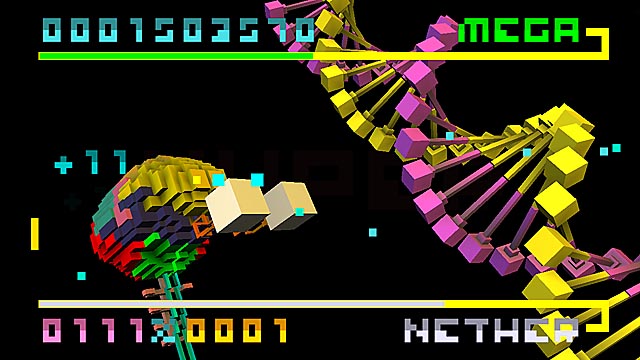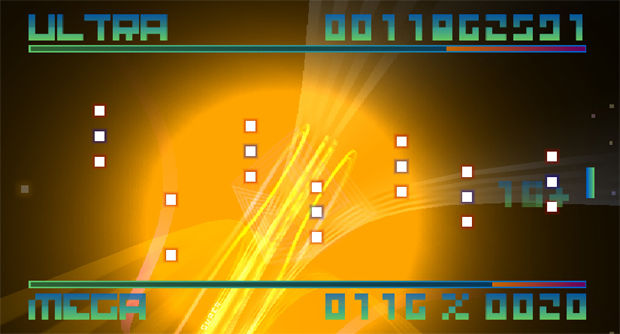
This collection of six WiiWare games feels like a refugee from a world where Atari and classic arcade games never died.
Imagine an alternate universe where something went haywire in the video game industry in the mid-1980s. Perhaps Atari never failed, or Nintendo never caught on, or arcades just got bigger and bigger. Perhaps in this universe the key technological advancement in gaming was not how we perceive games (graphics) but rather how we interact with games (controls).
Bit.Trip Complete is a visitor from this strange universe, only allowed in thanks to the strange temporal gateway that is the Wiimote. In our dimension, the Wiimote could have been the biggest interface change since the mouse, but one that has ultimately been a disappointment, rarely used as anything other than a surrogate controller by a bunch of shovelware and a handful of fully-formed games like No More Heroes. In the other dimension, the Bit.Trip games form a different concept of genre, each based on a different style of control.
This alternate Bit.universe is preferable to ours in many ways. It acknowledges that our physical interaction with the game – player input – is as or more important than our visual interaction – game output. Gamers are used to measuring frames per second on monitors and television, but response time from controller to screen doesn’t get that same analysis, beyond perhaps a descriptor of “sluggish” if something is seriously wrong.

The first game of the collection, Bit.Trip Beat, reimagines Pong through the Wiimote’s tilting effect. Hold the controller face-up and sideways, and tilt it towards or away from you to move the paddle up and down on the screen. Dots from the side approach, in different forms and patterns, to be driven back by intercepting them with the paddle. Each collision comes with its own note, which creates the melody that works with the electronic music in the background. By combining the core game mechanic with the game’s aural output, Bit.Trip Beat creates a coherent total experience, whether the game is soothing or hectic, easy or difficult – all with abstract graphics and a slight flick of the wrist as the primary control mechanism.
Developer Gaijin Games may have found a perfect use for the Wiimote’s tilt mechanism with Beat, but the next two imports from the Bit.universe do show the limits of isolating control mechanisms. Bit.Trip Core switches over to one of the weakest components of the Wiimote, the d-pad. Using a “core” at the center of the screen, you point in the direction of dots and hit a button in rhythm. Even though theoretically this is the same kind of gameplay as Beat, the difference in control renders Core much less usable. Too much interference from our universe causes the conventional d-pad/button combination to be ill-used here, thanks to the Wiimote’s tiny buttons and pad.
Attaching the nunchuk for the third game, Bit.Trip Fade, is initially an improvement, and the core idea seems to bear that out. Move a dot around the screen with the nunchuk, collecting black dots and avoiding white ones. Black ones cause your dot to grow, making it easier to hit the others. Pressing a button ejects the bulk and slims your dot down. Yet here the biggest cracks in the Bit.universe show up. While limited input and output can work for games like Beat, there’s little compelling about Fade, thanks largely to the nunchuk thumbstick’s limited movement. Neither speed nor precision are possible.
Perhaps realizing the flaws with Core and Fade, Gaijin gave its next two games a more coherent presentation. Both Bit.Trip Runner and Bit.Trip Fate put the series’ protagonist, Commander Video, on-screen, and both end up looking a lot more like games from our universe than the abstract forms of the Bit.universe. Runner looks like a platformer, where Fate is a shoot’em’up.

Yet appearances can deceiving. Close your eyes, and the gameplay mechanics and sounds of Bit.Trip Runner are the same as Bit.Trip Core’s, both controlled by using the Wiimote sideways and pressing buttons and the d-pad. Because Commander Video runs from left to right at the same speed throughout, Runner is really a rhythm game in platformer clothes. The sound effects, making beeps to go with the music with each jump or treasure collected, continue the same manner of using sound to encourage gameplay coherence. The graphics help with this – still abstract, but grounded enough to present something like a traveling narrative on each level.
Runner is also one of the most obviously difficult games of the package, but it only gives that appearance because it’s divided into shorter levels. Most of the other games have three long stages, each given an abstract name like “Epiphany”, which unlock in order after finishing the last. Runner has three worlds, each with a dozen or so smaller levels. Spending a minute at a time at an insanely difficult level is more palatable than being forced to restart a 10-minute level failed at the much-more-difficult ending.
This is the biggest problem with Bit.Trip Fate, an interesting form of a “bullet hell” shooter descended from Galaga combined with a rail shooter. A line appears on-screen, and you can move Commander Video forward and backward along the line, which has different directions in its track, allowing for dodging. Its control is the most conventional of the six games, with the nunchuk used for movement and the Wiimote used to aim Commander Video’s shots. Yet thanks to its constrained movement, long levels, and sudden spikes of difficulty with the boss of each level, Fate is arguably the most frustrating of the collection.

The difficulty issue, present in all of the games, is the best sign that maybe the Bit.universe isn’t actually a better gaming universe than our own. For as entertaining and difficult as the Bit.Trip games are in the first and second rounds of play, having to sit through seven minutes of the same thing in order to get to 20 seconds of extreme difficulty repeatedly proves to be a chore. Perhaps a worse offender than Fate is Fade, which has moments saying “checkpoint” but failure still boots you back to the beginning of the level. While our universe’s auto-and-quick-save friendly games may have removed a certain level of challenge from many games, it also offers a smoother and occasionally more customizable experience than the Bit.Trip games. But if you’re in the mood for that insane difficulty, each game in the collection has been given 20 fast-paced, tougher-than-normal Challenges for the Complete rerelease.
Which is why Bit.Trip Flux, the last game in the collection, is also probably the best-designed. Although in appearance and control it is identical to Bit.Trip Beat, the evolution of the series through multiple games gives Flux a slightly more polished sheen: the easy bits aren’t quite as boringly easy, the hard bits aren’t quite as overly challenging, and each level has clearly delineated checkpoint divisions (that successfully work when you get defeated!).
So while Bit.Trip Complete may offer a pleasant foray into an alternate universe where early arcade games still provide the model of game design, that’s a universe that might be more interesting to visit than it is to live in. But caught in the mesmerizing, Zen-like state of tilting the Wiimote perfectly in time with the rhythm of the music, yeah, maybe it’s worth staying in this Bit.universe for a little while longer.
Bit.Trip Complete was developed by Gaijin Games and published by Aksys Games. It is available for the Nintendo Wii.
Rowan Kaiser is a fashionably underemployed freelance writer living the San Francisco Bay Area, and has been published in The A.V. Club, Salon, The Escapist, GamePro, and more. He tweets often @rowankaiser and blogs rarely at renaissancegamer.blogspot.com.